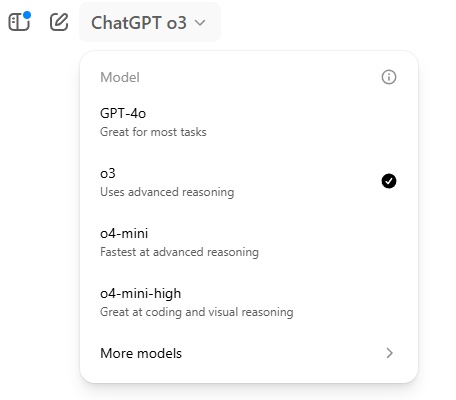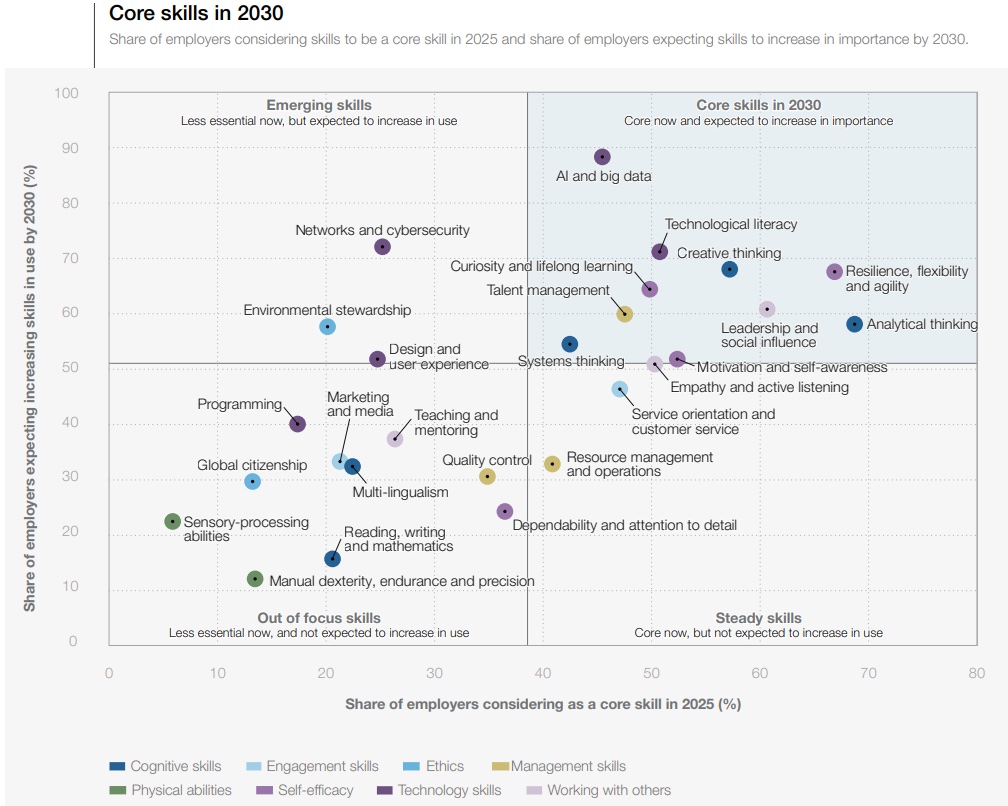My three interesting things this month…
1. AI Just Got A Big Upgrade – Here’s Why You Should Care
OpenAI recently launched its newest models for paying ChatGPT users, including a reasoning-focused model called o3. I’ve been testing it and I can say without hesitation, this is the biggest leap forward in AI I’ve seen yet. Anyone I demo this to, or who have tried it for themselves, agrees.
GPT-4o is the default model and it excels at quick, helpful responses across text, image and voice. The o3 model, on the other hand, is where to turn if you need depth.
It’s better at complex reasoning and holding context, making it much more effective for finance tasks that require nuance – like scenario planning, stakeholder comms or just straight up solving hard problems.
To access it, just click the dropdown arrow next to GPT-4o and select o3… then watch the magic happen. The first thing you’ll notice is that it takes a LOT longer to answer your prompt, up to a few minutes. But the wait is absolutely worth it.

Why does this matter for us in finance?
Because we’re not just number-crunchers anymore, we’re business partners. We’re increasingly asked to simplify complexity, tell clear stories with data and steer commercial decisions. The right AI tools will sharpen our thinking, speed up delivery and help us get to better insights faster.
AI use is already becoming more common. While AI won’t be replacing us anytime soon, someone who’s better with AI might.
When it comes to using AI, the future of work isn’t creeping in. It’s already here.
Leaders like Reid Hoffman have been talking about developing an “AI habit” – using tools like ChatGPT every day to experiment and learn. Shopify’s CEO, Tobi Lütke, has gone one step further and made AI usage mandatory for all staff.
So, if you’re not a paid user, it’s time to upgrade and it’s only £20/$20 per month. If you are a paid user, it’s time to start experimenting. Use GPT-4o for quick answers and fast drafting. Use o3 for everything else – drafting a board paper, redesigning a report or checking assumptions in a forecast.
A quick note: make your AI output human!
One highly actionable takeaway here: even as the tools get better, they’re still easy to spot. ChatGPT ‘watermarks’ the content it produces for you. If you’re sharing AI-generated content at work, be sure to clean up the giveaways, to make it feel like you’ve added a human touch.
- Take out all the Em dashes, the double length hyphens that look like this “—”. Especially the ones with no spaces between words. This is ChatGPT’s classic AI fingerprint. This double length hyphen symbol is not even on your keyboard! It’s the #1 AI giveaway.
- Edit American spellings, if you’re in the UK make sure to switch the Zs back to Ss – “organisation” from “organization”.
- Check for the consistent use of Oxford commas – a comma before an ‘and’. ChatGPT regularly gives 3 examples with a comma between the 2nd example and the “and”. Not many of us use this, it’s the final giveaway.
An example sentence with all 3 AI giveaways: I’m using ChatGPT—a large language model trained by OpenAI—to turbocharge tasks with the new o3 architecture’s ability to contextualize, summarize, and personalize content in a flash.
Rewritten: I’m using ChatGPT (a large language model trained by OpenAI) to turbocharge tasks with the new o3 architecture’s ability to summarise and personalise content.
See the difference this makes? Quick edits will make your outputs less robotic and much more you.
Have you used o3 yet? I’d love to hear how it’s going – get in touch and let me know.
2. Don’t Job-Hunt, Problem-Hunt
I’ve been having a lot of conversations recently with people thinking about their next career move. Maybe it’s a promotion, more money or it’s just time for something new.
The issue is, when we start thinking about career moves, we often default to looking at job titles or company names. But I’ve found a much more useful starting point: what’s the next big problem you want to solve?
This shift in thinking changes everything.
Rather than asking “what job do I want?”, ask:
- What kind of challenges am I excited to solve next?
- What problems do I find myself drawn to?
- How do I want to add value next?
When you start from this perspective, you’re no longer chasing someone else’s job description. You’re crafting your own path, anchored in what makes you curious, valuable and fulfilled.
But most importantly, it frames what you’re looking for in the way employers and managers think about it. You’re focusing on what they’re looking for, rather than what you want. You are aligning your goals with theirs.
Take a look at this chart from the World Economic Forum on the most important skills in the next 5 years – you can see it here. What’s rising fastest? Not technical accounting skills, but adaptability, problem-solving, analytical thinking and team leadership. These aren’t just bonuses – they’re the core skills employers are hiring for.
(Also note AI is up there!)

So, if you’re thinking about your next step, don’t start by updating your CV. Start by asking yourself: what problem do I want to solve next?
It might be improving decision-making with data, transforming finance processes or leading through a tricky strategic pivot. From there, look for roles, projects or stretch opportunities that align.
It’s not always about moving companies. Sometimes, the best next challenge is sitting right where you are – it just needs framing differently.
And if you’re not sure what the next challenge is? Get in touch if you’d like some help figuring that out.
3. Curation Is Your Leadership Superpower
If you’ve ever found yourself drowning in too much information – spreadsheets, dashboards, articles, tools, frameworks, podcasts – you’re not alone. In fact, content overload is now the default situation now for most finance leaders.
Which is why one of the most underrated leadership skills right now is curation.
Not knowing everything. Not doing everything. But being the person who can spot the signal through the noise, and surface what actually matters.
Fast Company recently described curation as the “new leadership superpower”, and I completely agree. In a world where AI can generate content on absolutely anything in seconds, incremental human value now lies in judgement.
Who can pick the most relevant insight? The most useful tool? The right AI prompt?
For finance leaders, this is pure gold. You don’t need to be the expert in every technical detail of Power BI, IFRS updates or ESG metrics. But you do need to be the one who can pull together the 5-minute summary, the key slide, the right article or a smart use of AI that unlocks something for your team.
Here’s something I’ve seen work well: create a “curation hub” for your team.
It could be a simple Notion page, OneNote section or even a pinned Teams message. Fill it with the tools, templates and articles you’ve personally found most useful. Then keep it live – add, prune, update. I’ve used this for the last 10 years. I use it every month to collect ideas for this newsletter!
Not only does this help your team find the good stuff faster, it signals something powerful: you’re a leader who filters, thinks and shares. And in a world flooded with content, that’s exactly the kind of leadership we need.
If you’re already curating great content, I’d love to hear what’s made it into your top 3 this month.
Want more insights?
Sign up to my interesting things newsletter to get tips like this and more.


